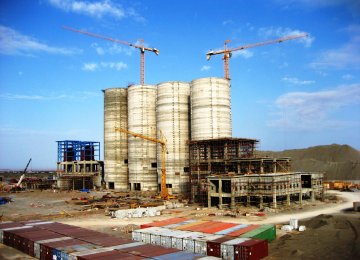Cement trading is scheduled to resume at Iran Mercantile Exchange’s exports trading board during the fourth quarter of the current Iranian year (Dec. 21-March 20), the head of Cement Employers Association, Abdolreza Sheikhan, said.
“The cement industry has been going through a rough patch in the past few years and the only thing that can improve the market’s condition is exports through IME,” Fars News Agency quoted Sheikhan as saying.
Founded in 2006, Iran Mercantile Exchange is a commodities exchange located in Tehran. IME trades in agricultural, industrial and petrochemical products in the spot and futures markets. It is mainly a domestic or regional market with the ambition of becoming more international in future.
IME offers a variety of services, including providing access to the initial offering of commodities, pricing for Iran’s over-the-counter, secondary markets and end users, providing a venue for government sales and procurement purchases, facilitating a trading platform and user interface, providing clearing & settlement services, risk management and technology services, as well as training of market participants.
According to Sheikhan, the IME entry provides cement industry players with many advantages, the most notable of them being transparency in the pricing of construction material.
“This in turn leads to the elimination of middlemen who disrupt the market balance, while fostering competition, boosting the quality of products and ensuring foreign buyers of the products’ origin,” he added.
The association is also in talks with IME to resume cement offerings in the commodity exchange’s domestic trading board.
“But it is too early, since we must first balance the glutted domestic market by boosting exports,” Sheikhan said.
Cement was last offered on IME’s main trading board from December 22, 2010, to March 21, 2012. During the period, demand and sales never exceeded their June 2011 highs of 200,000 and 170,000 tons respectively. By 2012, both demand and sales came to a near-complete halt.
Woebegone Industry
Iranian cement plants’ annual manufacturing capacity exceeds domestic market demand by more than 30 million tons, according to the deputy head of Planning and Budget Organization, Hamid Pourmohammadi.
Domestic production capacity is about 80 million tons per year, while demand stands at 50 million. There are more than 16 million tons of cement in excess of demand piled up in warehouses across the country, as the construction sector has yet to come out of recession.
Before the slump hit the cement industry, Iranian producers experienced a seven-year boom thanks to the controversial Mehr Housing Project–a large-scale scheme initiated in 2007 by the former administration to provide low-cost housing. The multibillion-dollar project slowed down over the years due to lack of funding, mismanagement and charges of fraud and embezzlement.
In the process, the huge slump hurt domestic demand for construction materials. Cement manufacturers were forced to find new export markets to draw down their bulging inventories.
The Iraqi market, which was once the main destination for Iranian cement, had until recently been the lifeline for domestic producers to cope with the recession in the construction sector. After the Iraqi government banned imports in April this year, Iran’s cement companies rushed to find new markets.
The government recently allocated $285.7 million in subsidies for cement transportation to new foreign markets.
Agreements with African countries have been signed and two cargos have been exported to Tanzania and Egypt. Cement companies have also signed a contract with Haitian officials for exporting to the Caribbean country.
The Ministry of Industries, Mining and Trade has set the target of 60% growth for domestic cement output over the next decade to reach 120 million tons. Exports are envisioned to rise 68% and reach 32 million tons.
More than 15 million tons of cement and clinker (the main material used in cement production) were exported in the last Iranian year that ended on March 19, 2016, with Iraq accounting for close to 65% of the figure. Exports dropped markedly in April after the Iraqi government imposed a ban on cement imports.
Production is also witnessing a downtrend as the 2015 output reached 58.6 million tons, down 12% from the previous year, according to CEA data.
The plummeting production led to a fall in Iran’s global ranking. The country stood three steps lower in 2015 from the previous year’s fourth position among the world’ top cement producers.






Add new comment
Read our comment policy before posting your viewpoints